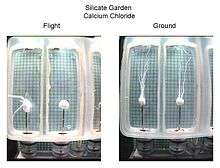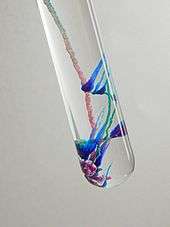Chemical garden
A chemical garden is an experiment in chemistry usually performed by adding metal salts, such as copper sulfate or cobalt(II) chloride, to an aqueous solution of sodium silicate (otherwise known as waterglass). This results in the growth of plant-like forms in minutes to hours.[1][2] [3] [4]

The chemical garden was first observed and described by Johann Rudolf Glauber in 1646.[5] In its original form, the chemical garden involved the introduction of ferrous chloride (FeCl2) crystals into a solution of potassium silicate (K2SiO3).
Process
The chemical garden relies on most transition metal silicates being insoluble in water and colored.
When a metal salt, such as cobalt chloride, is added to a sodium silicate solution, it will start to dissolve. It will then form insoluble cobalt silicate by a double displacement reaction (anion metathesis). This cobalt silicate is a semipermeable membrane. Because the ionic strength of the cobalt solution inside the membrane is higher than the sodium silicate solution's, which forms the bulk of the tank contents, osmotic effects will increase the pressure within the membrane. This will cause the membrane to tear, forming a hole. The cobalt cations will react with the silicate anions at this tear to form a new solid. In this way, growths will form in the tanks; they will be colored (according to the metal anion) and may look like plant-like structures. The crystals formed from this experiment will grow upwards, since the pressure at the bottom of the tank is higher than the pressure closer to the top of the tank, therefore forcing the crystals to grow upwards.
The upward direction of growth depends on the density of the fluid inside the semi-permeable membrane of the "plant" being lower than that of the surrounding waterglass solution. If one uses a metal salt that produces a very dense fluid inside the membrane, the growth is downward. For example, a green solution of trivalent chromium sulfate or chloride refuses to crystallize without slowly changing into the violet form, even if boiled until it concentrates into a tarry mass. That tar, if suspended in the waterglass solution, forms downward twig-like growths. This is because all the fluid inside the membrane is too dense to float and thereby exerts an upward pressure. The concentration of sodium silicate becomes important in growth rate.
After the growth has ceased, the sodium silicate solution can be removed by a continuous addition of water at a very slow rate. This prolongs the life of the garden. [6]
In one specific experimental variation, researchers produced the chemical garden inside test tubes. [7]
Common salts used
Common salts used in a chemical garden include:
- Aluminium potassium sulfate: White
- Copper(II) sulfate: Blue
- Chromium(III) chloride: Green
- Nickel(II) sulfate: Green
- Iron(II) sulfate: Green
- Iron(III) chloride: Orange
- Cobalt(II) chloride: Purple
- Calcium chloride: White
- Zinc sulfate: White
Practical uses
While at first the chemical garden may appear to be primarily a toy, some serious work has been done on the subject.[8] For instance, this chemistry is related to the setting of Portland cement, the formation of hydrothermal vents, and during the corrosion of steel surfaces on which insoluble tubes can be formed.
The nature of the growth of the insoluble silicate tubes formed within chemical gardens is also useful in understanding classes of related behavior seen in fluids separated by membranes. In various ways, the growth of the silicate tubes resembles the growth of spikes or blobs of ice extruded above the freezing surface of still water,[9] the patterns of growth of gum drying as it drips from wounds in trees such as Eucalyptus, and the way molten wax forms twig-like growths, either dripping from a candle, or floating up through cool water.
Paleontology
If the conditions are good, chemical gardens can also occur in nature. There is evidence from paleontology, that such chemical gardens may fossilize. Such pseudofossils can be very difficult to distinguish from fossilized organisms. Indeed, some of the earliest purported fossils of life might be fossilized chemical gardens.[10]
References
- Barge, Laura M.; Cardoso, Silvana S. S.; Cartwright, Julyan H. E.; Cooper, Geoffrey J. T.; Cronin, Leroy; De Wit, Anne; Doloboff, Ivria J.; Escribano, Bruno; Goldstein, Raymond E. (2015-08-26). "From Chemical Gardens to Chemobrionics". Chemical Reviews. 115 (16): 8652–8703. doi:10.1021/acs.chemrev.5b00014. ISSN 0009-2665.
- Balköse, D.; Özkan, F.; Köktürk, U.; Ulutan, S.; Ülkü, S.; Nişli, G. (2002). "Characterization of Hollow Chemical Garden Fibers from Metal Salts and Water Glass" (PDF). Journal of Sol-Gel Science and Technology. 23 (3): 253. doi:10.1023/A:1013931116107. hdl:11147/4652.
- Cartwright, J; García-Ruiz, Juan Manuel; Novella, María Luisa; Otálora, Fermín (2002). "Formation of Chemical Gardens". Journal of Colloid and Interface Science. 256 (2): 351. Bibcode:2002JCIS..256..351C. CiteSeerX 10.1.1.7.7604. doi:10.1006/jcis.2002.8620.
- Thouvenel-Romans, S; Steinbock, O (Apr 2003). "Oscillatory growth of silica tubes in chemical gardens" (PDF). Journal of the American Chemical Society. 125 (14): 4338–41. doi:10.1021/ja0298343. ISSN 0002-7863. PMID 12670257. Archived from the original (PDF) on 2017-08-11. Retrieved 2009-05-23.
- Glauber, Johann Rudolf (1646). "LXXXV. Wie man in diesem Liquore von allen Metallen in wenig Stunden Bäume mit Farben soll wachsen machen. (How one shall make grow—in this solution, from all metals, in a few hours—trees with color)". Furni Novi Philosophici (German-language 1661 ed.). Amsterdam: Johan Jansson. pp. 186–189.
- Helmenstine, Anne Marie (2019-03-16). "Magic Rocks". thoughtco.com. Archived from the original on 2020-05-16. Retrieved 2020-05-16.
- Glaab, F.; Kellermeier, M.; Kunz, W.; Morallon, E.; García-Ruiz, J. M. (2012). "Formation and Evolution of Chemical Gradients and Potential Differences Across Self-Assembling Inorganic Membranes". Angew. Chem. Int. Ed. 51 (18): 4317–4321. doi:10.1002/anie.201107754. PMID 22431259.
- Julyan H. E. Cartwright, Juan Manuel García-Ruiz, María Luisa Novella, and Fermín Otálora, J. Colloid Interface Sci. 2002, 256, 351–359. "Archived copy". Archived from the original on 2007-03-11. Retrieved 2006-02-05.CS1 maint: archived copy as title (link)
- "Ice Formations Diurnal Freeze-Thaw Cycles".
- McMahon, Sean (2020). "Earth's earliest and deepest purported fossils may be iron-mineralized chemical gardens". Proc. R. Soc. B. 286 (1916). doi:10.1098/rspb.2019.2410.
External links
| Wikimedia Commons has media related to Silicate garden. |
- Chemical Garden at The Periodic Table of Videos (University of Nottingham)
- Chemical Gardens (Colloidal garden) at (http://chemistry-chemists.com)
- Chemobrionics (COST Action linking European research groups to stimulate innovative and high-impact interdisciplinary scientintific research on chemical gardens)
